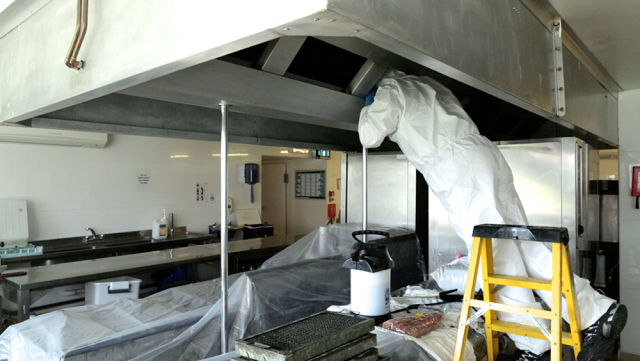Design for the best

As the new TR19 Grease specification is issued by BESA, Gary Nicholls explains why some building managers may still find that there are challenges to achieving full compliance.
Since the introduction of TR/17 and its successor TR/19, the leading industry guidance document on ventilation hygiene issued by BESA, there has, quite rightly been a greater emphasis on the need for cleanliness in supply ventilation and extract ductwork. In the case of extract ductwork serving kitchens in particular, the industry has become increasingly aware of the very real fire hazard which failure to comply with TR/19 can create.
For this reason, a new specification, TR19 Grease, has been developed from Section 7 of the second edition of the earlier TR19, and has been given status as a separate specification which contractors must follow. At the same time, TR19 has now been reissued without Section 7, so that it concentrates on cleanliness in mechanical ventilation systems.
Compliance with both these specifications is vital. Failure to comply carries some serious consequences. In residential settings, poor air quality which can be caused by dirty ductwork, can result in the exacerbation of chronic conditions such as asthma, while in commercial properties, poor air quality can lead to sickness, absence and a costly loss of productivity. In hospitals, poorly cleaned ventilation ductwork has even been known to spread infection and disease.
Failure to comply with the new TR19 Grease specification means that you also fail to control a serious potential fire risk. The airborne grease particles which arise from cooking create deposits which accumulate on the inner surfaces of kitchen extract ductwork. In order to be compliant, this grease layer must be controlled within an average thickness of 200 microns, about half the thickness of an average business card. Allowing the grease layer to accumulate above this will represent an ever increasing and potentially serious fire risk.
Should a kitchen extract ductwork fire occur, which, unfortunately, they do all too often, smoke and flames can be carried through the ductwork to cause damage through many other parts of the property and potentially to spread to adjoining properties. This can affect both commercial and domestic properties, putting lives at risk.
The Regulatory Reform (Fire Safety) Order 2005 requires an organisation to appoint a Responsible Person whose task it is to ensure that fire risks are reduced and controlled. If a fire breaks out in ductwork which is later deemed not to be compliant with TR19 Grease, the Responsible Person can be prosecuted. A conviction can carry a custodial sentence, especially in cases where a fatality has occurred.
Buildings insurance can also be compromised. Insurers understandably expect building managers and property owners to comply with fire risk management regulations. If you fail to comply, you may well find that your insurer will refuse to pay out following a fire and may impose stringent, unpalatable conditions and premiums on any future insurance cover. They may even refuse to cover your property.
Despite greater awareness of the importance of compliance with TR19, we still routinely see ventilation and kitchen extract systems which pose some serious challenges to compliance. The cause is fairly simple – lack of access. If we cannot access the full extent of a ductwork system, we cannot make all of it compliant with TR19 or TR19 Grease.
After installation has occurred, the importance of maintaining adequate access to the ductwork is not always understood. The interior designer or architect understandably seeks to make a beautiful interior and does not always bear in mind that TR19 compliance in ventilation ductwork will be an ongoing issue. In some instances, we find that solid ceilings have been constructed across the ductwork, or false walls installed, obscuring the ductwork.
This can be a major problem. It is hard to tell whether sufficient doors exist, but have been covered up, or if additional doors are needed. Rectifying the situation can be disruptive and costly, requiring service hatches in the beautiful solid ceiling. Although solid ceilings may be more aesthetically pleasing, suspended ceilings are often a better choice for facilitating compliance. When cleaning at height, an access platform may also be required to clean safely and this should be factored in at the design stage. Ideally, future compliance should be on the agenda from the initial design of every building’s ventilation system.

In many cases, we can retrofit additional access doors to improve access and make ductwork compliant. However, in some cases we see fixed ceilings or walls covering ductwork so that a system is inaccessible and does not allow ongoing TR19 or TR19 Grease compliance without very costly remodelling.
Ventilation systems must be designed and installed in accordance with DW144 for ordinary ductwork or DW172 for kitchen extract ductwork, but ironically, these do not include the full remit of access points which are required for compliance with TR19 or TR19 Grease. If you are able to influence the design and installation, we strongly recommend designing ductwork systems to include sufficient access and allow for ongoing future compliance.
It is now also essential to select your ductwork cleaning contractor with great care. TR19 Grease now calls for every clean to be certified through the Building Engineering Services Competence Assessment (BESCA) Ventilation Hygiene Elite (VHE) Scheme. Contractors must be members of the VHE in order to provide this. This certification does require a minimal fee; we believe this is a small price to pay both for peace of mind and to help demonstrate compliance and diligence to insurers or investigating authorities. It may also be that insurers will look more favourably on VHE certified cleans in future and it may be worth factoring certification into a renegotiation of more favourable insurance terms.
We have been keen to see kitchen extract ductwork have its own specification for some time, due to the very real fire hazard which non-compliance with TR19 has caused. We see the consequences of non-compliance on a frequent basis, even in instances where our customers have had previous cleaning contractors who they believed, misguidedly, were providing TR19 compliance.
Some of this is due to poor standards of cleaning and/or lack of training, but some is undoubtedly due to the inaccessibility of sections of a system. An appropriate level of training and competence also features as a requirement of the new specification, and for the past 24 months, BESA accredited training schools have been developing the skills of hundreds of grease hygiene technicians in readiness for this new specification.
Requiring a registration through VHE will ensure that more specialist cleaning providers join this excellent scheme, and we hope that this new step will encourage an increase in the standards of compliance across our entire industry.
It is all too easy to underestimate the degree to which the health and safety of a building relies on the health and safety of its ductwork. It is our sincere hope that this new, entirely welcome TR19 Grease specification will go some way towards raising both awareness and standards of compliance, thus leading to improved fire safety controls throughout the UK.
Gary Nicholls is managing director of Swiftclean and co-author of TR/17 - TR/19 series







